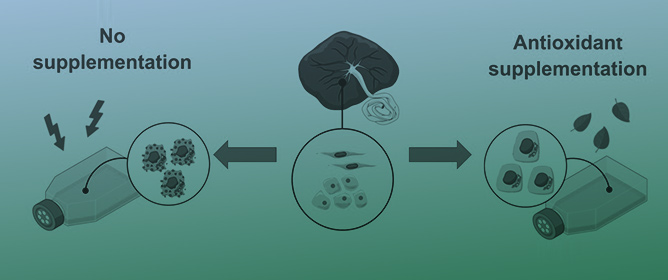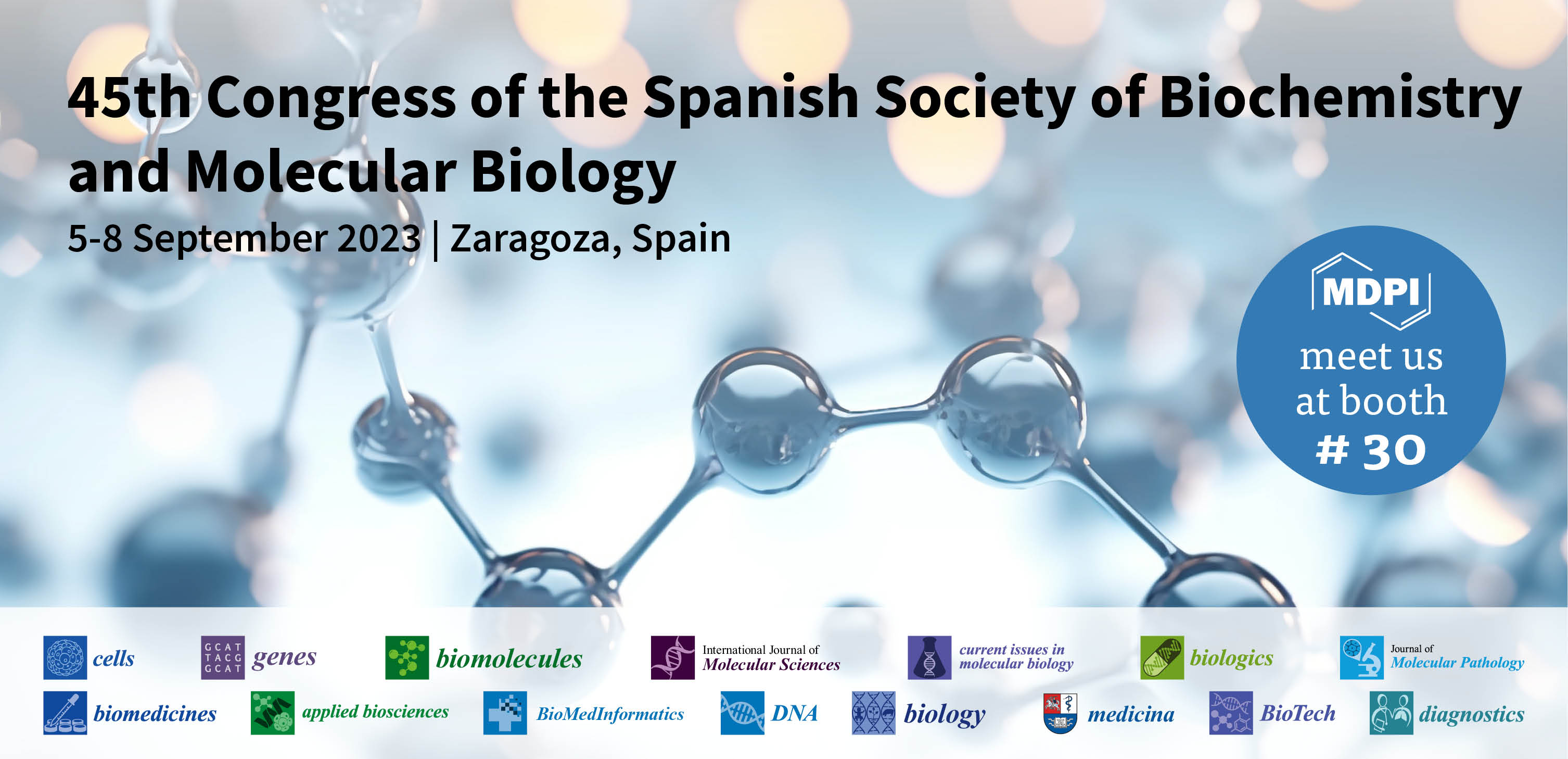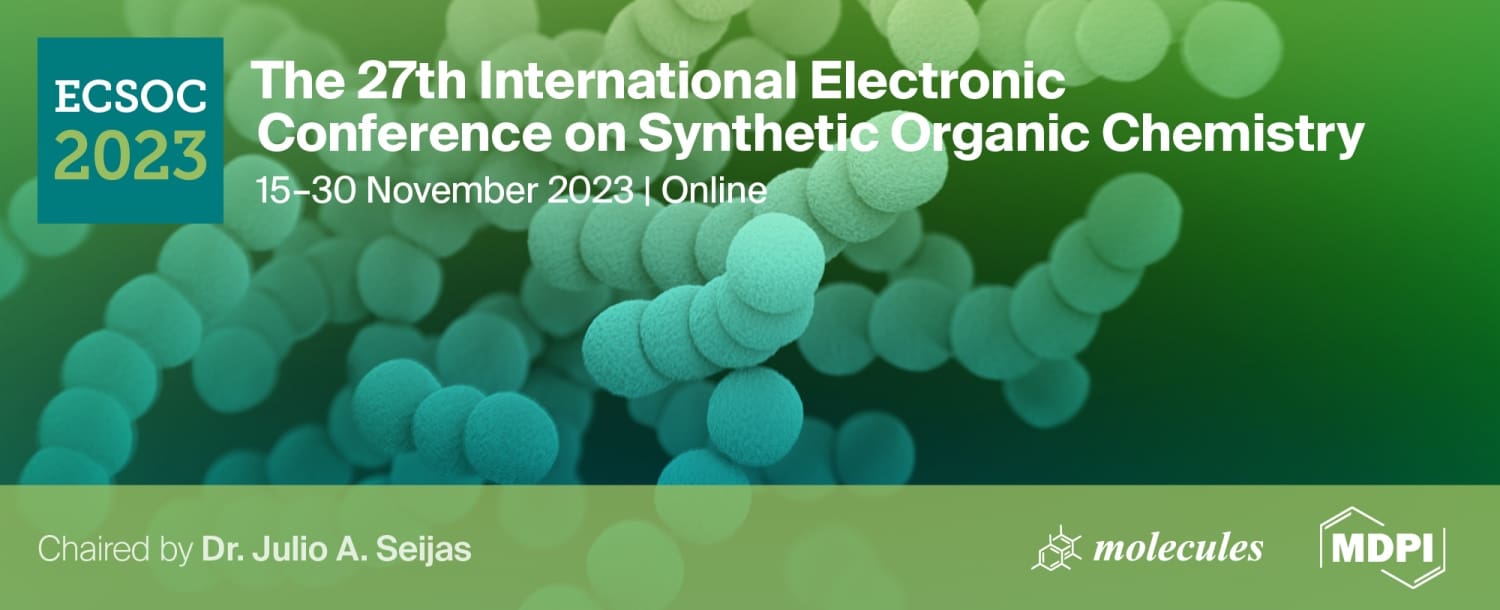Journal Description
Biomolecules
Biomolecules
is a peer-reviewed, open access journal on structures and functions of bioactive and biogenic substances, molecular mechanisms with biological and medical implications as well as biomaterials and their applications. Biomolecules is published monthly online by MDPI. The Spanish Society for Biochemistry and Molecular Biology (SEBBM) is affiliated with Biomolecules and their members receive discounts on the article processing charges.
- Open Access— free for readers, with article processing charges (APC) paid by authors or their institutions.
- High Visibility: indexed within Scopus, SCIE (Web of Science), PubMed, MEDLINE, PMC, Embase, CAPlus / SciFinder, and other databases.
- Journal Rank: JCR - Q1 (Biochemistry & Molecular Biology) / CiteScore - Q1 (Biochemistry)
- Rapid Publication: manuscripts are peer-reviewed and a first decision is provided to authors approximately 19.2 days after submission; acceptance to publication is undertaken in 2.9 days (median values for papers published in this journal in the first half of 2023).
- Recognition of Reviewers: reviewers who provide timely, thorough peer-review reports receive vouchers entitling them to a discount on the APC of their next publication in any MDPI journal, in appreciation of the work done.
- Sections: published in 19 topical sections.
- Testimonials: See what our editors and authors say about Biomolecules.
- Companion journal: Receptors.
Impact Factor:
5.5 (2022);
5-Year Impact Factor:
5.8 (2022)
Latest Articles
Non-Invasive Retinal Blood Vessel Wall Measurements with Polarization-Sensitive Optical Coherence Tomography for Diabetes Assessment: A Quantitative Study
Biomolecules 2023, 13(8), 1230; https://doi.org/10.3390/biom13081230 - 08 Aug 2023
Abstract
Diabetes affects the structure of the blood vessel walls. Since the blood vessel walls are made of birefringent organized tissue, any change or damage to this organization can be evaluated using polarization-sensitive optical coherence tomography (PS-OCT). In this paper, we used PS-OCT along
[...] Read more.
Diabetes affects the structure of the blood vessel walls. Since the blood vessel walls are made of birefringent organized tissue, any change or damage to this organization can be evaluated using polarization-sensitive optical coherence tomography (PS-OCT). In this paper, we used PS-OCT along with the blood vessel wall birefringence index (BBI = thickness/birefringence2) to non-invasively assess the structural integrity of the human retinal blood vessel walls in patients with diabetes and compared the results to those of healthy subjects. PS-OCT measurements revealed that blood vessel walls of diabetic patients exhibit a much higher birefringence while having the same wall thickness and therefore lower BBI values. Applying BBI to diagnose diabetes demonstrated high accuracy (93%), sensitivity (93%) and specificity (93%). PS-OCT measurements can quantify small changes in the polarization properties of retinal vessel walls associated with diabetes, which provides researchers with a new imaging tool to determine the effects of exercise, medication, and alternative diets on the development of diabetes.
Full article
(This article belongs to the Special Issue Molecular Pathology, Diagnostics and Therapeutics of Retinal Diseases)
►
Show Figures
Open AccessArticle
IGF/mTORC1/S6 Signaling Is Potentiated and Prolonged by Acute Loading of Subtoxicological Manganese Ion
Biomolecules 2023, 13(8), 1229; https://doi.org/10.3390/biom13081229 - 08 Aug 2023
Abstract
The insulin-like growth factor (IGF)/insulin signaling (IIS) pathway is involved in cellular responses against intracellular divalent manganese ion (Mn2+) accumulation. As a pathway where multiple nodes utilize Mn2+ as a metallic co-factor, how the IIS signaling patterns are affected by
[...] Read more.
The insulin-like growth factor (IGF)/insulin signaling (IIS) pathway is involved in cellular responses against intracellular divalent manganese ion (Mn2+) accumulation. As a pathway where multiple nodes utilize Mn2+ as a metallic co-factor, how the IIS signaling patterns are affected by Mn2+ overload is unresolved. In our prior studies, acute Mn2+ exposure potentiated IIS kinase activity upon physiological-level stimulation, indicated by elevated phosphorylation of protein kinase B (PKB, also known as AKT). AKT phosphorylation is associated with IIS activity; and provides direct signaling transduction input for the mammalian target of rapamycin complex 1 (mTORC1) and its downstream target ribosomal protein S6 (S6). Here, to better define the impact of Mn2+ exposure on IIS function, Mn2+-induced IIS activation was evaluated with serial concentrations and temporal endpoints. In the wild-type murine striatal neuronal line STHdh, the acute treatment of Mn2+ with IGF induced a Mn2+ concentration-sensitive phosphorylation of S6 at Ser235/236 to as low as 5 μM extracellular Mn2+. This effect required both the essential amino acids and insulin receptor (IR)/IGF receptor (IGFR) signaling input. Similar to simultaneous stimulation of Mn2+ and IGF, when a steady-state elevation of Mn2+ was established via a 24-h pre-exposure, phosphorylation of S6 also displayed higher sensitivity to sub-cytotoxic Mn2+ when compared to AKT phosphorylation at Ser473. This indicates a synergistic effect of sub-cytotoxic Mn2+ on IIS and mTORC1 signaling. Furthermore, elevated intracellular Mn2+, with both durations, led to a prolonged activation in AKT and S6 upon stimulation. Our data demonstrate that the downstream regulator S6 is a highly sensitive target of elevated Mn2+ and is well below the established acute cytotoxicity thresholds (<50 μM). These findings indicate that the IIS/mTORC1 pathways, in which Mn2+ normally serves as an essential co-factor, are dually responsible for the cellular changes in exposures to real-world Mn2+ concentrations.
Full article
(This article belongs to the Special Issue Advances in Metal Toxicology—A Honorary Special Issue Commemorating the Research of Prof. Michael Aschner in Metal Toxicity)
►▼
Show Figures

Figure 1
Open AccessReview
The Mechanisms of Action of Hyperbaric Oxygen in Restoring Host Homeostasis during Sepsis
Biomolecules 2023, 13(8), 1228; https://doi.org/10.3390/biom13081228 - 07 Aug 2023
Abstract
The perception of sepsis has shifted over time; however, it remains a leading cause of death worldwide. Sepsis is now recognized as an imbalance in host cellular functions triggered by the invading pathogens, both related to immune cells, endothelial function, glucose and oxygen
[...] Read more.
The perception of sepsis has shifted over time; however, it remains a leading cause of death worldwide. Sepsis is now recognized as an imbalance in host cellular functions triggered by the invading pathogens, both related to immune cells, endothelial function, glucose and oxygen metabolism, tissue repair and restoration. Many of these key mechanisms in sepsis are also targets of hyperbaric oxygen (HBO2) treatment. HBO2 treatment has been shown to improve survival in clinical studies on patients with necrotizing soft tissue infections as well as experimental sepsis models. High tissue oxygen tension during HBO2 treatment may affect oxidative phosphorylation in mitochondria. Oxygen is converted to energy, and, as a natural byproduct, reactive oxygen species are produced. Reactive oxygen species can act as mediators, and both these and the HBO2-mediated increase in oxygen supply have the potential to influence the cellular processes involved in sepsis. The pathophysiology of sepsis can be explained comprehensively through resistance and tolerance to infection. We argue that HBO2 treatment may protect the host from collateral tissue damage during resistance by reducing neutrophil extracellular traps, inhibiting neutrophil adhesion to vascular endothelium, reducing proinflammatory cytokines, and halting the Warburg effect, while also assisting the host in tolerance to infection by reducing iron-mediated injury and upregulating anti-inflammatory measures. Finally, we show how inflammation and oxygen-sensing pathways are connected on the cellular level in a self-reinforcing and detrimental manner in inflammatory conditions, and with support from a substantial body of studies from the literature, we conclude by demonstrating that HBO2 treatment can intervene to maintain homeostasis.
Full article
(This article belongs to the Special Issue Advances in Oxygen Therapy with a Special Focus on Immunomodulation and Infection)
►▼
Show Figures

Figure 1
Open AccessSystematic Review
Therapeutic Role of Pharmacological Chaperones in Lysosomal Storage Disorders: A Review of the Evidence and Informed Approach to Reclassification
by
, , , , , , , , , and
Biomolecules 2023, 13(8), 1227; https://doi.org/10.3390/biom13081227 - 07 Aug 2023
Abstract
The treatment landscape for lysosomal storage disorders (LSDs) is rapidly evolving. An increase in the number of preclinical and clinical studies in the last decade has demonstrated that pharmacological chaperones are a feasible alternative to enzyme replacement therapy (ERT) for individuals with LSDs.
[...] Read more.
The treatment landscape for lysosomal storage disorders (LSDs) is rapidly evolving. An increase in the number of preclinical and clinical studies in the last decade has demonstrated that pharmacological chaperones are a feasible alternative to enzyme replacement therapy (ERT) for individuals with LSDs. A systematic search was performed to retrieve and critically assess the evidence from preclinical and clinical applications of pharmacological chaperones in the treatment of LSDs and to elucidate the mechanisms by which they could be effective in clinical practice. Publications were screened according to the Preferred Reporting Items for Systematic reviews and Meta-Analyses (PRISMA) reporting guidelines. Fifty-two articles evaluating 12 small molecules for the treatment of seven LSDs are included in this review. Overall, a substantial amount of preclinical and clinical data support the potential of pharmacological chaperones as treatments for Fabry disease, Gaucher disease, and Pompe disease. Most of the available clinical evidence evaluated migalastat for the treatment of Fabry disease. There was a lack of consistency in the terminology used to describe pharmacological chaperones in the literature. Therefore, the new small molecule chaperone (SMC) classification system is proposed to inform a standardized approach for new, emerging small molecule therapies in LSDs.
Full article
(This article belongs to the Special Issue Lysosomal Diseases: From Molecular Features to Precision Medicine)
►▼
Show Figures

Figure 1
Open AccessArticle
Indole-3-Acetamido-Polyamines as Antimicrobial Agents and Antibiotic Adjuvants
by
, , , , , and
Biomolecules 2023, 13(8), 1226; https://doi.org/10.3390/biom13081226 - 07 Aug 2023
Abstract
The widespread incidence of antimicrobial resistance necessitates the discovery of new classes of antimicrobials as well as adjuvant molecules that can restore the action of ineffective antibiotics. Herein, we report the synthesis of a new class of indole-3-acetamido-polyamine conjugates that were evaluated for
[...] Read more.
The widespread incidence of antimicrobial resistance necessitates the discovery of new classes of antimicrobials as well as adjuvant molecules that can restore the action of ineffective antibiotics. Herein, we report the synthesis of a new class of indole-3-acetamido-polyamine conjugates that were evaluated for antimicrobial activities against a panel of bacteria and two fungi, and for the ability to enhance the action of doxycycline against Pseudomonas aeruginosa and erythromycin against Escherichia coli. Compounds 14b, 15b, 17c, 18a, 18b, 18d, 19b, 19e, 20c and 20d exhibited strong growth inhibition of methicillin-resistant Staphylococcus aureus (MRSA) and Cryptococcus neoformans, with minimum inhibitory concentrations (MIC) typically less than 0.2 µM. Four analogues, including a 5-bromo 15c and three 5-methoxyls 16d–f, also exhibited intrinsic activity towards E. coli. Antibiotic kill curve analysis of 15c identified it to be a bactericide. While only one derivative was found to (weakly) enhance the action of erythromycin against E. coli, three examples, including 15c, were found to be strong enhancers of the antibiotic action of doxycycline against P. aeruginosa. Collectively, these results highlight the promising potential of α,ω-disubstituted indole-3-acetamido polyamine conjugates as antimicrobials and antibiotic adjuvants.
Full article
(This article belongs to the Special Issue Recent Advances in Antimicrobial Agents)
►▼
Show Figures
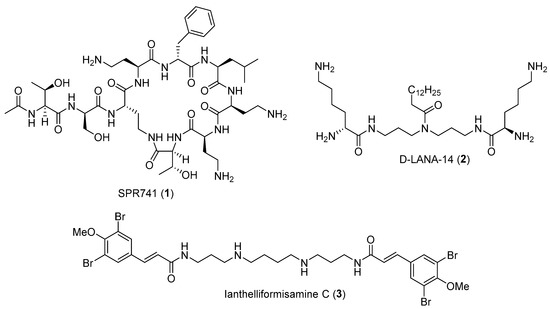
Figure 1
Open AccessReview
Mechanisms of Modulation of Mitochondrial Architecture
Biomolecules 2023, 13(8), 1225; https://doi.org/10.3390/biom13081225 - 07 Aug 2023
Abstract
Mitochondrial network architecture plays a critical role in cellular physiology. Indeed, alterations in the shape of mitochondria upon exposure to cellular stress can cause the dysfunction of these organelles. In this scenario, mitochondrial dynamics proteins and the phospholipid composition of the mitochondrial membrane
[...] Read more.
Mitochondrial network architecture plays a critical role in cellular physiology. Indeed, alterations in the shape of mitochondria upon exposure to cellular stress can cause the dysfunction of these organelles. In this scenario, mitochondrial dynamics proteins and the phospholipid composition of the mitochondrial membrane are key for fine-tuning the modulation of mitochondrial architecture. In addition, several factors including post-translational modifications such as the phosphorylation, acetylation, SUMOylation, and o-GlcNAcylation of mitochondrial dynamics proteins contribute to shaping the plasticity of this architecture. In this regard, several studies have evidenced that, upon metabolic stress, mitochondrial dynamics proteins are post-translationally modified, leading to the alteration of mitochondrial architecture. Interestingly, several proteins that sustain the mitochondrial lipid composition also modulate mitochondrial morphology and organelle communication. In this context, pharmacological studies have revealed that the modulation of mitochondrial shape and function emerges as a potential therapeutic strategy for metabolic diseases. Here, we review the factors that modulate mitochondrial architecture.
Full article
(This article belongs to the Section Molecular Medicine)
►▼
Show Figures

Figure 1
Open AccessBrief Report
SARS-CoV-2 Infection in Unvaccinated High-Risk Pregnant Women in the Bronx, NY, USA Is Associated with Decreased Apgar Scores and Placental Villous Infarcts
by
, , , , , , , , and
Biomolecules 2023, 13(8), 1224; https://doi.org/10.3390/biom13081224 - 06 Aug 2023
Abstract
Babies born to severe acute respiratory syndrome corona virus-2 (SARS-CoV-2)-infected mothers are at greater risk for perinatal morbidity and more likely to receive a neurodevelopmental diagnosis in the first year of life. However, the effect of maternal infection on placental function and neonatal
[...] Read more.
Babies born to severe acute respiratory syndrome corona virus-2 (SARS-CoV-2)-infected mothers are at greater risk for perinatal morbidity and more likely to receive a neurodevelopmental diagnosis in the first year of life. However, the effect of maternal infection on placental function and neonatal outcomes varies depending upon the patient population. We set out to test our hypothesis that maternal SARS-CoV-2 infection in our underserved, socioeconomically disadvantaged, mostly unvaccinated, predominantly African American and Latina population in the Bronx, NY would have effects evident at birth. Under IRB approval, 56 SARS-CoV-2-positive patients infected during the “first wave” of the pandemic with alpha and beta strains of the virus, 48 patients infected during the “second wave” of the pandemic with delta and omicron strains and 61 negative third-trimester high-risk patients were randomly selected from Montefiore Medical Center (MMC), Bronx, NY. In addition, two positive cases from Yale New Haven Hospital, CT were included as controls. All 104 placentas delivered by SARS-CoV-2-positive mothers were uninfected by the virus, based on immunohistochemistry, in situ hybridization, and qPCR analysis. However, placental villous infarcts were significantly increased in first-wave cases compared to second-wave cases or negative controls. Significantly lower Apgar scores at 1 min and 5 min were observed in neonates born to infected mothers with severe symptoms. These findings suggest that even without entering the placenta, SARS-CoV-2 can affect various systemic pathways, culminating in altered placental development and function, which may adversely affect the fetus, especially in a high-risk patient population such as ours. These results underline the importance of vaccination among pregnant women, particularly in low-resource areas.
Full article
(This article belongs to the Collection Feature Papers in Molecular Reproduction)
►▼
Show Figures
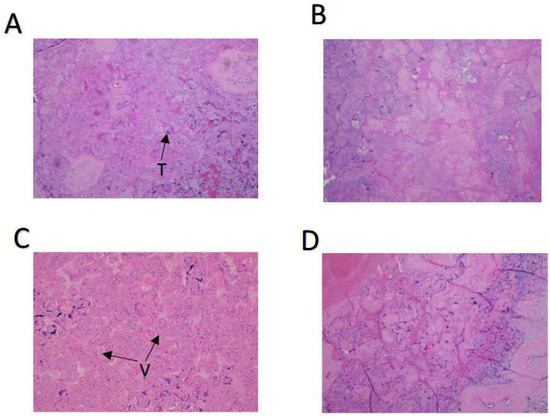
Figure 1
Open AccessReview
Wiggle and Shake: Managing and Exploiting Conformational Dynamics during Proteasome Biogenesis
Biomolecules 2023, 13(8), 1223; https://doi.org/10.3390/biom13081223 - 06 Aug 2023
Abstract
The 26S proteasome is the largest and most complicated protease known, and changes to proteasome assembly or function contribute to numerous human diseases. Assembly of the 26S proteasome from its ~66 individual polypeptide subunits is a highly orchestrated process requiring the concerted actions
[...] Read more.
The 26S proteasome is the largest and most complicated protease known, and changes to proteasome assembly or function contribute to numerous human diseases. Assembly of the 26S proteasome from its ~66 individual polypeptide subunits is a highly orchestrated process requiring the concerted actions of both intrinsic elements of proteasome subunits, as well as assistance by extrinsic, dedicated proteasome assembly chaperones. With the advent of near-atomic resolution cryo-electron microscopy, it has become evident that the proteasome is a highly dynamic machine, undergoing numerous conformational changes in response to ligand binding and during the proteolytic cycle. In contrast, an appreciation of the role of conformational dynamics during the biogenesis of the proteasome has only recently begun to emerge. Herein, we review our current knowledge of proteasome assembly, with a particular focus on how conformational dynamics guide particular proteasome biogenesis events. Furthermore, we highlight key emerging questions in this rapidly expanding area.
Full article
(This article belongs to the Special Issue Allosteric Regulation in Ubiquitin Proteasome System)
►▼
Show Figures
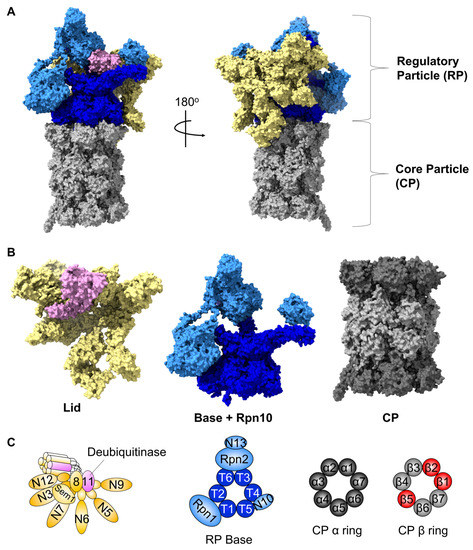
Figure 1
Open AccessArticle
Relationship of Fibroblast Growth Factor 23 Serum Levels with Disease Characteristics in Systemic Lupus Erythematosus Patients
by
, , , , , , , , , and
Biomolecules 2023, 13(8), 1222; https://doi.org/10.3390/biom13081222 - 05 Aug 2023
Abstract
Fibroblast growth factor 23 (FGF23), a hormone secreted by osteocytes and osteoblasts, is a major regulator of vitamin D and phosphate homeostasis. FGF23 has been associated with the disturbance of mineral homeostasis, and with kidney and cardiovascular diseases. Systemic lupus erythematosus (SLE) is
[...] Read more.
Fibroblast growth factor 23 (FGF23), a hormone secreted by osteocytes and osteoblasts, is a major regulator of vitamin D and phosphate homeostasis. FGF23 has been associated with the disturbance of mineral homeostasis, and with kidney and cardiovascular diseases. Systemic lupus erythematosus (SLE) is an autoimmune disorder that can affect virtually any organ. In the present work, we set out to analyze the relationship of FGF23 with the expression of SLE, including patterns of activity, damage, and severity. A total of 284 well-characterized patients with SLE were recruited. Activity (SLEDAI), severity (Katz), and damage index (SLICC-DI) scores were determined. The serum levels of FGF23 were also assessed. Multivariable linear regression analysis was performed to study the relationship between disease characteristics and FGF23. FGF23 and 25(OH) vitamin D were negatively correlated. Furthermore, prednisone use was associated with higher circulating FGF23 after an adjustment for confounding factors. SLICC-DI was related to higher serum levels of FGF23 after a multivariable analysis. However, when the SLICC-DI index items and domains were analyzed separately, apart from proteinuria ≥3.5 gm/24 h, only the musculoskeletal domain, encompassing arthritis and osteoporosis, was significantly associated with higher serum levels of FGF23. In conclusion, an association is observed between elevated serum FGF23 levels and disease damage, particularly related to musculoskeletal complications and proteinuria, in patients with SLE.
Full article
(This article belongs to the Special Issue Biomarkers in Systemic Lupus Erythematosus)
►▼
Show Figures

Figure 1
Open AccessReview
Oxidative Stress as a Regulatory Checkpoint in the Production of Antiphospholipid Autoantibodies: The Protective Role of NRF2 Pathway
by
, , , , , , and
Biomolecules 2023, 13(8), 1221; https://doi.org/10.3390/biom13081221 - 05 Aug 2023
Abstract
Oxidative stress is a well-known hallmark of Antiphospholipid Antibody Syndrome (APS), a systemic autoimmune disease characterized by arterial and venous thrombosis and/or pregnancy morbidity. Oxidative stress may affect various signaling pathways and biological processes, promoting dysfunctional immune responses and inflammation, inducing apoptosis, deregulating
[...] Read more.
Oxidative stress is a well-known hallmark of Antiphospholipid Antibody Syndrome (APS), a systemic autoimmune disease characterized by arterial and venous thrombosis and/or pregnancy morbidity. Oxidative stress may affect various signaling pathways and biological processes, promoting dysfunctional immune responses and inflammation, inducing apoptosis, deregulating autophagy and impairing mitochondrial function. The chronic oxidative stress and the dysregulation of the immune system leads to the loss of tolerance, which drives autoantibody production and inflammation with the development of endothelial dysfunction. In particular, anti-phospholipid antibodies (aPL), which target phospholipids and/or phospholipid binding proteins, mainly β-glycoprotein I (β-GPI), play a functional role in the cell signal transduction pathway(s), thus contributing to oxidative stress and thrombotic events. An oxidation–antioxidant imbalance may be detected in the blood of patients with APS as a reflection of disease progression. This review focuses on functional evidence highlighting the role of oxidative stress in the initiation and progression of APS. The protective role of food supplements and Nuclear Factor Erythroid 2-Related Factor 2 (NRF2) activators in APS patients will be summarized to point out the potential of these therapeutic approaches to reduce APS-related clinical complications.
Full article
(This article belongs to the Special Issue Novel Insights into the Role of Autoantibodies in Diseases)
►▼
Show Figures

Figure 1
Open AccessReview
The Neurobiological Underpinnings of Obsessive-Compulsive Symptoms in Psychosis, Translational Issues for Treatment-Resistant Schizophrenia
by
, , , , , , , and
Biomolecules 2023, 13(8), 1220; https://doi.org/10.3390/biom13081220 - 05 Aug 2023
Abstract
Almost 25% of schizophrenia patients suffer from obsessive-compulsive symptoms (OCS) considered a transdiagnostic clinical continuum. The presence of symptoms pertaining to both schizophrenia and obsessive-compulsive disorder (OCD) may complicate pharmacological treatment and could contribute to lack or poor response to the therapy. Despite
[...] Read more.
Almost 25% of schizophrenia patients suffer from obsessive-compulsive symptoms (OCS) considered a transdiagnostic clinical continuum. The presence of symptoms pertaining to both schizophrenia and obsessive-compulsive disorder (OCD) may complicate pharmacological treatment and could contribute to lack or poor response to the therapy. Despite the clinical relevance, no reviews have been recently published on the possible neurobiological underpinnings of this comorbidity, which is still unclear. An integrative view exploring this topic should take into account the following aspects: (i) the implication for glutamate, dopamine, and serotonin neurotransmission as demonstrated by genetic findings; (ii) the growing neuroimaging evidence of the common brain regions and dysfunctional circuits involved in both diseases; (iii) the pharmacological modulation of dopaminergic, serotoninergic, and glutamatergic systems as current therapeutic strategies in schizophrenia OCS; (iv) the recent discovery of midbrain dopamine neurons and dopamine D1- and D2-like receptors as orchestrating hubs in repetitive and psychotic behaviors; (v) the contribution of N-methyl-D-aspartate receptor subunits to both psychosis and OCD neurobiology. Finally, we discuss the potential role of the postsynaptic density as a structural and functional hub for multiple molecular signaling both in schizophrenia and OCD pathophysiology.
Full article
(This article belongs to the Special Issue Recent Advances in Neuropharmacology and Brain Physiology)
►▼
Show Figures
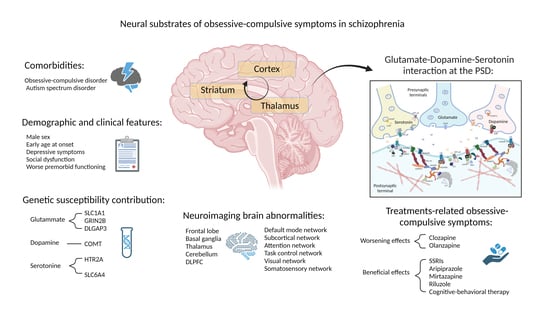
Graphical abstract
Open AccessArticle
Phosphoserine Aminotransferase Pathogenetic Variants in Serine Deficiency Disorders: A Functional Characterization
by
, , , , , , , , , , and
Biomolecules 2023, 13(8), 1219; https://doi.org/10.3390/biom13081219 - 04 Aug 2023
Abstract
In humans, the phosphorylated pathway (PP) converts the glycolytic intermediate D-3-phosphoglycerate (3-PG) into L-serine through the enzymes 3-phosphoglycerate dehydrogenase, phosphoserine aminotransferase (PSAT) and phosphoserine phosphatase. From the pathogenic point of view, the PP in the brain is particularly relevant, as genetic defects of
[...] Read more.
In humans, the phosphorylated pathway (PP) converts the glycolytic intermediate D-3-phosphoglycerate (3-PG) into L-serine through the enzymes 3-phosphoglycerate dehydrogenase, phosphoserine aminotransferase (PSAT) and phosphoserine phosphatase. From the pathogenic point of view, the PP in the brain is particularly relevant, as genetic defects of any of the three enzymes are associated with a group of neurometabolic disorders known as serine deficiency disorders (SDDs). We recombinantly expressed and characterized eight variants of PSAT associated with SDDs and two non-SDD associated variants. We show that the pathogenetic mechanisms in SDDs are extremely diverse, including low affinity of the cofactor pyridoxal 5′-phosphate and thermal instability for S179L and G79W PSAT, loss of activity of the holo form for R342W PSAT, aggregation for D100A PSAT, increased Km for one of the substrates with invariant kcats for S43R PSAT, and a combination of increased Km and decreased kcat for C245R PSAT. Finally, we show that the flux through the in vitro reconstructed PP at physiological concentrations of substrates and enzymes is extremely sensitive to alterations of the functional properties of PSAT variants, confirming PSAT dysfunctions as a cause of SSDs.
Full article
(This article belongs to the Special Issue Alterations in D-amino Acid Metabolism in Psychiatric and Neurological Disorders)
►▼
Show Figures
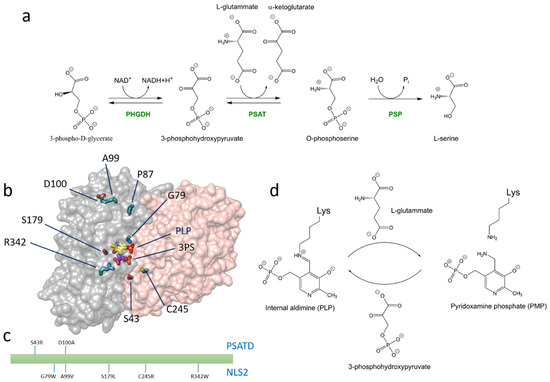
Figure 1
Open AccessArticle
The Impact of Viral Infection on the Chemistries of the Earth’s Most Abundant Photosynthesizes: Metabolically Talented Aquatic Cyanobacteria
Biomolecules 2023, 13(8), 1218; https://doi.org/10.3390/biom13081218 - 04 Aug 2023
Abstract
Cyanobacteria are the most abundant photosynthesizers on earth, and as such, they play a central role in marine metabolite generation, ocean nutrient cycling, and the control of planetary oxygen generation. Cyanobacteriophage infection exerts control on all of these critical processes of the planet,
[...] Read more.
Cyanobacteria are the most abundant photosynthesizers on earth, and as such, they play a central role in marine metabolite generation, ocean nutrient cycling, and the control of planetary oxygen generation. Cyanobacteriophage infection exerts control on all of these critical processes of the planet, with the phage-ported homologs of genes linked to photosynthesis, catabolism, and secondary metabolism (marine metabolite generation). Here, we analyze the 153 fully sequenced cyanophages from the National Center for Biotechnology Information (NCBI) database and the 45 auxiliary metabolic genes (AMGs) that they deliver into their hosts. Most of these AMGs are homologs of those found within cyanobacteria and play a key role in cyanobacterial metabolism-encoding proteins involved in photosynthesis, central carbon metabolism, phosphate metabolism, methylation, and cellular regulation. A greater understanding of cyanobacteriophage infection will pave the way to a better understanding of carbon fixation and nutrient cycling, as well as provide new tools for synthetic biology and alternative approaches for the use of cyanobacteria in biotechnology and sustainable manufacturing.
Full article
(This article belongs to the Special Issue Marine-Derived Molecules with Different Bioactivities)
►▼
Show Figures
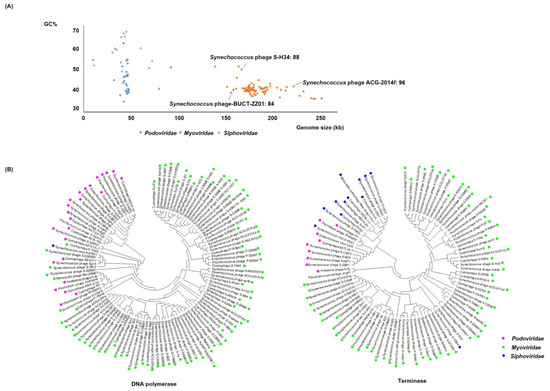
Figure 1
Open AccessReview
Autophagy/Mitophagy in Airway Diseases: Impact of Oxidative Stress on Epithelial Cells
Biomolecules 2023, 13(8), 1217; https://doi.org/10.3390/biom13081217 - 04 Aug 2023
Abstract
Autophagy is the key process by which the cell degrades parts of itself within the lysosomes. It maintains cell survival and homeostasis by removing molecules (particularly proteins), subcellular organelles, damaged cytoplasmic macromolecules, and by recycling the degradation products. The selective removal or degradation
[...] Read more.
Autophagy is the key process by which the cell degrades parts of itself within the lysosomes. It maintains cell survival and homeostasis by removing molecules (particularly proteins), subcellular organelles, damaged cytoplasmic macromolecules, and by recycling the degradation products. The selective removal or degradation of mitochondria is a particular type of autophagy called mitophagy. Various forms of cellular stress (oxidative stress (OS), hypoxia, pathogen infections) affect autophagy by inducing free radicals and reactive oxygen species (ROS) formation to promote the antioxidant response. Dysfunctional mechanisms of autophagy have been found in different respiratory diseases such as chronic obstructive lung disease (COPD) and asthma, involving epithelial cells. Several existing clinically approved drugs may modulate autophagy to varying extents. However, these drugs are nonspecific and not currently utilized to manipulate autophagy in airway diseases. In this review, we provide an overview of different autophagic pathways with particular attention on the dysfunctional mechanisms of autophagy in the epithelial cells during asthma and COPD. Our aim is to further deepen and disclose the research in this direction to stimulate the develop of new and selective drugs to regulate autophagy for asthma and COPD treatment.
Full article
(This article belongs to the Special Issue The Role of Epithelial Cells in Airway Diseases)
►▼
Show Figures

Figure 1
Open AccessFeature PaperArticle
Immune and Reproductive Biomarkers in Female Sea Urchins Paracentrotus lividus under Heat Stress
by
, , , , , and
Biomolecules 2023, 13(8), 1216; https://doi.org/10.3390/biom13081216 - 04 Aug 2023
Abstract
The functioning of the immune and reproductive systems is crucial for the fitness and survival of species and is strongly influenced by the environment. To evaluate the effects of short-term heat stress (HS) on these systems, confirming and deepening previous studies, female sea
[...] Read more.
The functioning of the immune and reproductive systems is crucial for the fitness and survival of species and is strongly influenced by the environment. To evaluate the effects of short-term heat stress (HS) on these systems, confirming and deepening previous studies, female sea urchin Paracentrotus lividus were exposed for 7 days to 17 °C, 23 and 28 °C. Several biomarkers were detected such as the ferric reducing power (FRAP), ABTS-based total antioxidant capacity (TAC-ABTS), nitric oxide metabolites (NOx), total thiol levels (TTL), myeloperoxidase (MPO) and protease (PA) activities in the coelomic fluid (CF) and mitochondrial membrane potential (MMP), H2O2 content and intracellular pH (pHi) in eggs and coelomocytes, in which TAC-ABTS and reactive nitrogen species (RNS) were also analyzed. In the sea urchins exposed to HS, CF analysis showed a decrease in FRAP levels and an increase in TAC-ABTS, TTL, MPO and PA levels; in coelomocytes, RNS, MMP and H2O2 content increased, whereas pHi decreased; in eggs, increases in MMP, H2O2 content and pHi were found. In conclusion, short-term HS leads to changes in five out of the six CF biomarkers analyzed and functional alterations in the cells involved in either reproductive or immune activities.
Full article
(This article belongs to the Special Issue State of the Art Molecular Reproduction in Italy: A Themed Issue in Honor of Professor Loredana Di Matteo)
►▼
Show Figures

Figure 1
Open AccessArticle
Biochemical Characterization of the Copper Nitrite Reductase from Neisseria gonorrhoeae
Biomolecules 2023, 13(8), 1215; https://doi.org/10.3390/biom13081215 - 04 Aug 2023
Abstract
The copper-containing nitrite reductase from Neisseria gonorrhoeae has been shown to play a critical role in the infection mechanism of this microorganism by producing NO and abolishing epithelial exfoliation. This enzyme is a trimer with a type 1 copper center per subunit and
[...] Read more.
The copper-containing nitrite reductase from Neisseria gonorrhoeae has been shown to play a critical role in the infection mechanism of this microorganism by producing NO and abolishing epithelial exfoliation. This enzyme is a trimer with a type 1 copper center per subunit and a type 2 copper center in the subunits interface, with the latter being the catalytic site. The two centers were characterized for the first time by EPR and CD spectroscopy, showing that the type 1 copper center has a high rhombicity due to its lower symmetry and more tetragonal structure, while the type 2 copper center has the usual properties, but with a smaller hyperfine coupling constant (A// = 10.5 mT). The thermostability of the enzyme was analyzed by differential scanning calorimetry, which shows a single endothermic transition in the thermogram, with a maximum at 94 °C, while the CD spectra in the visible region indicate the presence of the type 1 copper center up to 80 °C. The reoxidation of the N. gonorrhoeae copper-containing nitrite reductase in the presence of nitrite were analyzed by visible spectroscopy and showed a pH dependence, being higher at pH 5.5–6.0. The high thermostability of this enzyme may be important to maintaining a high activity in the extracellular space and to making it less susceptible to denaturation and proteolysis, contributing to the proliferation of N. gonorrhoeae.
Full article
(This article belongs to the Special Issue Biomolecule-Metal Ion Interaction)
►▼
Show Figures
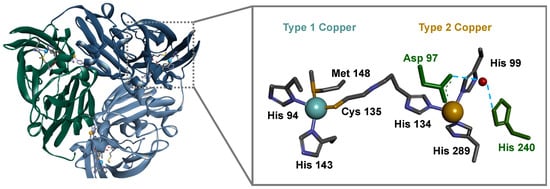
Figure 1
Open AccessArticle
Del1 Is a Growth Factor for Skeletal Progenitor Cells in the Fracture Callus
by
, , , , , , , , , , , and
Biomolecules 2023, 13(8), 1214; https://doi.org/10.3390/biom13081214 - 03 Aug 2023
Abstract
Failure to properly form bone or integrate surgical implants can lead to morbidity and additional surgical interventions in a significant proportion of orthopedic surgeries. While the role of skeletal stem cells (SSCs) in bone formation and repair is well-established, very little is known
[...] Read more.
Failure to properly form bone or integrate surgical implants can lead to morbidity and additional surgical interventions in a significant proportion of orthopedic surgeries. While the role of skeletal stem cells (SSCs) in bone formation and repair is well-established, very little is known about the factors that regulate the downstream Bone, Cartilage, Stromal, Progenitors (BCSPs). BCSPs, as transit amplifying progenitor cells, undergo multiple mitotic divisions to expand the pool of lineage committed progenitors allowing stem cells to preserve their self-renewal and stemness. Del1 is a protein widely expressed in the skeletal system, but its deletion led to minimal phenotype changes in the uninjured mouse. In this paper, we demonstrate that Del1 is a key regulator of BCSP expansion following injury. In Del1 knockout mice, there is a significant reduction in the number of BCSPs which leads to a smaller callus and decreased bone formation compared with wildtype (WT) littermates. Del1 serves to promote BCSP proliferation and prevent apoptosis in vivo and in vitro. Moreover, exogenous Del1 promotes proliferation of aged human BCSPs. Our results highlight the potential of Del1 as a therapeutic target for improving bone formation and implant success. Del1 injections may improve the success of orthopedic surgeries and fracture healing by enhancing the proliferation and survival of BCSPs, which are crucial for generating new bone tissue during the process of bone formation and repair.
Full article
(This article belongs to the Topic Bone-Related Diseases: From Molecular Mechanisms to Therapy Development)
►▼
Show Figures
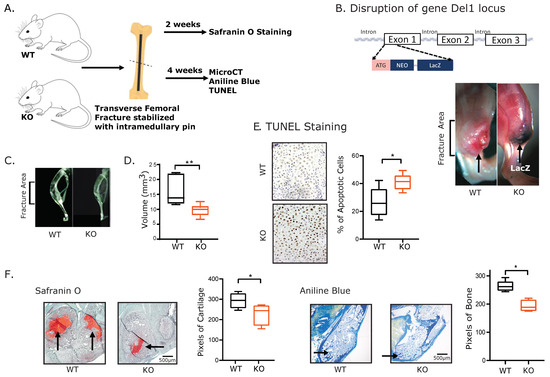
Figure 1
Open AccessReview
The Molecular Mechanisms of HLA-G Regulatory Function on Immune Cells during Early Pregnancy
Biomolecules 2023, 13(8), 1213; https://doi.org/10.3390/biom13081213 - 03 Aug 2023
Abstract
Human leukocyte antigen-G (HLA-G) is a non-classical human major histocompatibility complex (MHC-I) molecule with the membrane-bound and soluble types. HLA-G is primarily expressed by extravillous cytotrophoblast cells located at the maternal–fetal interface during pregnancy and is essential in establishing immune tolerance. This review
[...] Read more.
Human leukocyte antigen-G (HLA-G) is a non-classical human major histocompatibility complex (MHC-I) molecule with the membrane-bound and soluble types. HLA-G is primarily expressed by extravillous cytotrophoblast cells located at the maternal–fetal interface during pregnancy and is essential in establishing immune tolerance. This review provides a comprehensive understanding of the multiple molecular mechanisms by which HLA-G regulates the immune function of NK cells. It highlights that HLA-G binds to microRNA to suppress NK cell cytotoxicity and stimulate the secretion of growth factors to support fetal growth. The interactions between HLA-G and NK cells also activate senescence signaling, promoting spiral artery remodeling and maintaining the balance of maternal–fetal immune responses. In addition, HLA-G can inhibit the function of decidual T cells, dendritic cells, and macrophages. Overall, the interaction between trophoblast cells and immune cells mediated by HLA-G plays a crucial role in understanding immune regulation at the maternal–fetal interface and offers insights into potential treatments for pregnancy-related diseases.
Full article
(This article belongs to the Section Molecular Reproduction)
►▼
Show Figures

Figure 1
Open AccessArticle
A Combination of Conformation-Specific RAF Inhibitors Overcome Drug Resistance Brought about by RAF Overexpression
by
, , , , , , , , and
Biomolecules 2023, 13(8), 1212; https://doi.org/10.3390/biom13081212 - 02 Aug 2023
Abstract
Cancer cells often adapt to targeted therapies, yet the molecular mechanisms underlying adaptive resistance remain only partially understood. Here, we explore a mechanism of RAS/RAF/MEK/ERK (MAPK) pathway reactivation through the upregulation of RAF isoform (RAFs) abundance. Using computational modeling and in vitro experiments,
[...] Read more.
Cancer cells often adapt to targeted therapies, yet the molecular mechanisms underlying adaptive resistance remain only partially understood. Here, we explore a mechanism of RAS/RAF/MEK/ERK (MAPK) pathway reactivation through the upregulation of RAF isoform (RAFs) abundance. Using computational modeling and in vitro experiments, we show that the upregulation of RAFs changes the concentration range of paradoxical pathway activation upon treatment with conformation-specific RAF inhibitors. Additionally, our data indicate that the signaling output upon loss or downregulation of one RAF isoform can be compensated by overexpression of other RAF isoforms. We furthermore demonstrate that, while single RAF inhibitors cannot efficiently inhibit ERK reactivation caused by RAF overexpression, a combination of two structurally distinct RAF inhibitors synergizes to robustly suppress pathway reactivation.
Full article
(This article belongs to the Special Issue MAP Kinases: Functions in Signal Transduction and Disease)
►▼
Show Figures

Figure 1
Open AccessArticle
A Comparison of Cell-Cell Interaction Prediction Tools Based on scRNA-seq Data
Biomolecules 2023, 13(8), 1211; https://doi.org/10.3390/biom13081211 - 02 Aug 2023
Abstract
Computational prediction of cell-cell interactions (CCIs) is becoming increasingly important for understanding disease development and progression. We present a benchmark study of available CCI prediction tools based on single-cell RNA sequencing (scRNA-seq) data. By comparing prediction outputs with a manually curated gold standard
[...] Read more.
Computational prediction of cell-cell interactions (CCIs) is becoming increasingly important for understanding disease development and progression. We present a benchmark study of available CCI prediction tools based on single-cell RNA sequencing (scRNA-seq) data. By comparing prediction outputs with a manually curated gold standard for idiopathic pulmonary fibrosis (IPF), we evaluated prediction performance and processing time of several CCI prediction tools, including CCInx, CellChat, CellPhoneDB, iTALK, NATMI, scMLnet, SingleCellSignalR, and an ensemble of tools. According to our results, CellPhoneDB and NATMI are the best performer CCI prediction tools, among the ones analyzed, when we define a CCI as a source-target-ligand-receptor tetrad. In addition, we recommend specific tools according to different types of research projects and discuss the possible future paths in the field.
Full article
(This article belongs to the Section Bioinformatics and Systems Biology)
►▼
Show Figures
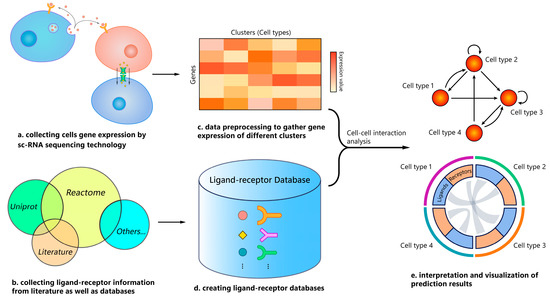
Figure 1

Journal Menu
► ▼ Journal Menu-
- Biomolecules Home
- Aims & Scope
- Editorial Board
- Reviewer Board
- Topical Advisory Panel
- Instructions for Authors
- Special Issues
- Topics
- Sections & Collections
- Article Processing Charge
- Indexing & Archiving
- Editor’s Choice Articles
- Most Cited & Viewed
- Journal Statistics
- Journal History
- Journal Awards
- Society Collaborations
- Conferences
- Editorial Office
Journal Browser
► ▼ Journal BrowserHighly Accessed Articles
Latest Books
E-Mail Alert
News
Topics
Topic in
Biomolecules, IJMS, Molecules, Sci. Pharm., Cancers, Marine Drugs
Antitumor Activity of Natural Products and Related Compounds
Topic Editors: Barbara De Filippis, Alessandra Ammazzalorso, Marialuigia FantacuzziDeadline: 31 August 2023
Topic in
Biomolecules, Cells, CIMB, IJMS, JMP, Molecules, Proteomes
Metalloproteins and Metalloenzymes
Topic Editors: Eugene A. Permyakov, Ludmilla Morozova-RocheDeadline: 30 September 2023
Topic in
Biology, Biomolecules, Cells, JCM, Organoids
Organ Fibrosis: From Molecular Mechanisms to Clinical Therapies
Topic Editors: Maurizio Onisto, Valentina MasolaDeadline: 31 October 2023
Topic in
Antioxidants, Biomolecules, Molecules, Pharmaceutics, Separations
Application of Analytical Chemistry in Exercise Physiology and Pharmacology
Topic Editors: Andrzej Pokrywka, Dorota KwiatkowskaDeadline: 15 November 2023

Conferences
Special Issues
Special Issue in
Biomolecules
Human Gut Microbiome and Diet in Health and Diseases
Guest Editor: Luis VitettaDeadline: 10 August 2023
Special Issue in
Biomolecules
Molecular Pathology, Diagnostics and Therapeutics of Retinal Diseases
Guest Editor: Antonio FerrerasDeadline: 15 August 2023
Special Issue in
Biomolecules
Molecular Effects of Environmental Pollutants on Health of Human, Animals and Plants
Guest Editor: Marina PiscopoDeadline: 31 August 2023
Special Issue in
Biomolecules
Role of Connexins in Hereditary Diseases
Guest Editor: Mona M. FreidinDeadline: 15 September 2023
Topical Collections
Topical Collection in
Biomolecules
Multi-Organ Alcohol-Related Damage: Mechanisms and Treatment
Collection Editors: Natalia Osna, Kusum K. Kharbanda
Topical Collection in
Biomolecules
RNA Modifications
Collection Editors: Valérie De Crécy-Lagard, Juan Alfonzo
Topical Collection in
Biomolecules
Archaea: Diversity, Metabolism and Molecular Biology
Collection Editor: Hannu Myllykallio
Topical Collection in
Biomolecules
Recent Advances in Cancer Immunotherapy
Collection Editor: Kenichi Suda





